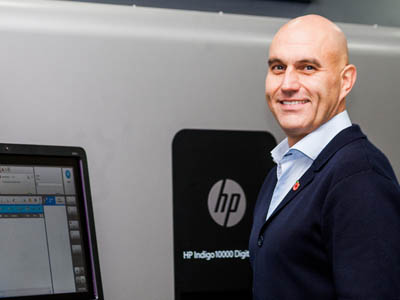CPI Colour general manager Lee Reeves
CPI Colour has integrated its MIS and prepress workflow. Andy Knaggs discovers the benefits.
Lee Reeves knew what he wanted. All it needed for the plan to come together was for his team to want the same thing. He gave them the information so that they could make their own minds up, and the result, 12 months ago, was a modern printing operation tightly bound together with an integrated Imprint MIS and Kodak’s Prinergy workflow and Insite portal. The benefits of integration – increased automation and efficiency throughout the business – have swiftly followed.
Mr Reeves is the general manager at CPI Colour in Croydon – what was once Mike Taylor’s Fulmar – a high quality print supplier producing work such as report and accounts, top end books and auction catalogues, using B1 litho and HP Indigo 10000 digital print capability. Mr Reeves joined CPI in December 2013, tasked with focusing on streamlining the organisation’s UK Commercial Division and strengthening its brand positioning.
It quickly became a priority to pay some attention to the software that underpinned the business however. CPI had already installed Imprint MIS, but it was only being used in silos, with modules still operating independently of each other. Since joining the company, Mr Reeves has been driving full integration of Imprint throughout the whole job cycle, from request for quote (RFQ) to receipt of payment. This is an ongoing project.
Collaboration is key
Mr Reeves said that Imprint has shown itself to be a collaborative vendor, prepared to work closely with CPI to ensure the system delivers results.
The situation with workflow and prepress software also needed addressing. The Screen Trueflow prepress workflow had received no investment for a number of years and had become cumbersome and unstable.
Mr Reeves commented: ‘We needed a workflow, and I had worked with Kodak Prinergy and Insite previously. Generally, today, a workflow is pretty much a workflow – there’s little to differentiate one from another. Where Kodak scores is in the way that Insite looks and the way it behaves for our customers; in the flexibility of Rules Based Automation, if you are striving for full automation as we are; and in the open approach that Kodak takes in working with any MIS provider willing to work with it.’
No imposition
Despite Mr Reeves’ own experience with the Kodak software, which made him keen to bring this into CPI, it was not something that he wanted to impose from above. In fact, he was very keen to ensure there was buy-in from those whose roles would demand regular engagement directly with the software.
‘It has always been important to me that my colleagues who will be using the workflow day to day are part of the purchasing decision,’ he explained. ‘In this case, our senior operators had workflows demonstrated to them by four main vendors. Although I knew what I wanted the outcome to be, it was important for them to come to a decision as to what they believed would be most beneficial to the business. Kodak was their choice as much as it was mine.’
CPI Colour now has an MIS which is being used as intended: collecting actionable management information from all areas of the organisation to help make good business decisions. This is complemented by the Kodak Insite prepress portal. When a job comes in through Insite, the job details are automatically converted to JDF, which is used to run the operation in a fully automated manner. This has improved service to CPI’s customers, has assisted communication throughout the manufacturing process and in turn has given CPI the ability to reduce costs.
As was mentioned previously, Rules Based Automation (RBA) is a key component within the Kodak Prinergy workflow. It allows users to automate tasks, helping to eliminate errors, speed up processes and reduce costs. Kodak’s own research on printers using RBA suggests that it can deliver a 10-20% increase in productivity through basic rules such as automated preflighting and auto-archiving, while combining RBA with Prinergy and Insite might reduce prepress costs to the tune of 30-60%.
Hands off
It has certainly had a big impact at CPI Colour, with Mr Reeves saying that it has ‘radically reduced the touch points within our business and eliminated many points of double handling’. He added: ‘RBA has given us the ability to return ripped PDF proofs to our clients, within literally seconds of the last page being uploaded.’
Kodak Insite has also had a major impact, quite apart from functioning as a highly effective and user-friendly portal for customers. ‘The real effect on the business is having it working hand in hand with RBA,’ said Mr Reeves. ‘When used well, RBA seamlessly turns the cogs, while Insite allows the clients to see the results in a very clear and secure manner.’
Customers have been impressed with the changes, he reports, saying that they love the idea of having a single mechanism for file transfer, and the fact that their files sit securely behind CPI’s firewall in a drive dedicated to them. They know that they can upload files 24/7 and be certain that they are moving through the system, rather than just being stuck in a file transfer window waiting for an operator. Proofing has also now become a much quicker process, as proofs are generated even if CPI’s studio is unmanned.
Every change project has its problems and challenges, and this one was no different, but the support and interaction of both Kodak and Imprint was certainly an invaluable factor in pulling off a successful integration at CPI Colour. There were cultural and technological barriers to overcome, but success was helped by the fact that the team at CPI saw benefits start to accrue very quickly, giving them confidence to embrace the cultural change.
Read the full issue online here





